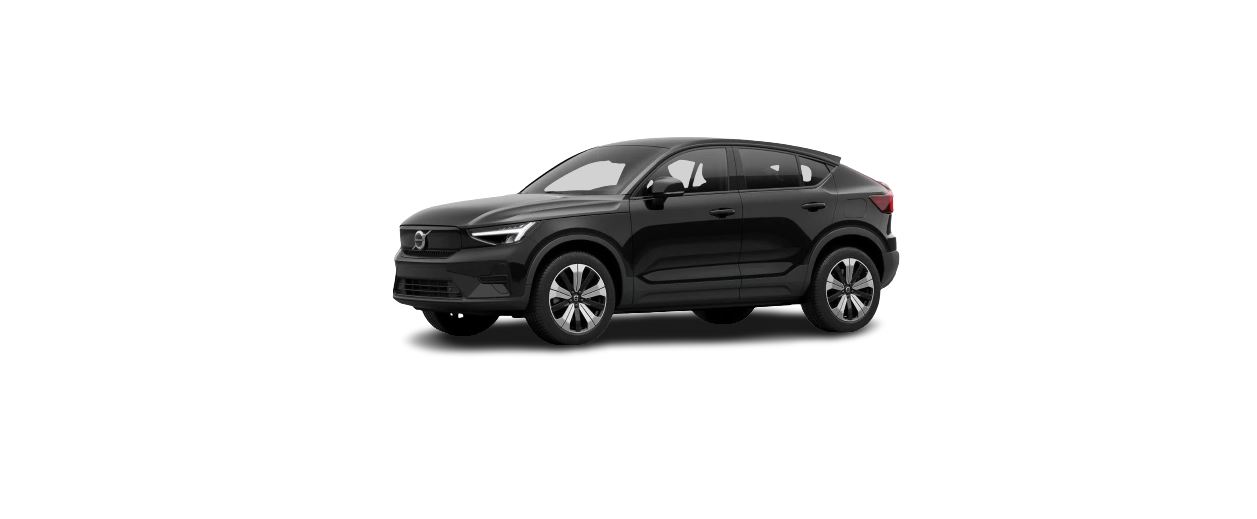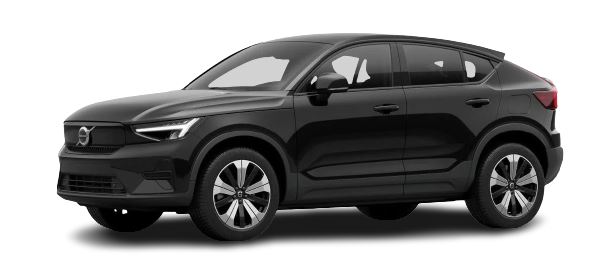2023 Volvo C40 Recharge Charging the high voltage battery
Charging status in the car’s driver display
| Colour | Status | Specification |
|---|---|---|
| Pulsating green | The frame of the driver display is shown with a green pulsing light. | Charging continues and an approximate time is shown for when the car will be fully charged. |
| Green | The frame of the driver display is shown with a fixed green light. | The car has finished charging. |
| Red | The frame of the driver display is shown with a fixed red light. | A fault has arisen. Check the charging cable’s connection to the car’s charging input socket and power source.
Then restart charging in the following steps:
|
| Blue | The frame of the driver display is shown with a fixed blue light. | Scheduled Charging activated. |
| Yellow | The frame of the driver display is shown with a fixed yellow light. | Charging is waiting to start or paused charging. |
In addition to showing charging status, the driver display includes the following:
- existing and set amperage, as well as number of phases(Existing and set amperage applies per phase from the alternating current source)
- Charging power
- Battery percentage
- time until the car has finished charging.
Note
If the driver display is not used for a while then it is dimmed. Activate the display again by opening one of the doors. Read more in the section on driver display.
Charging status in the car’s charging input socket
| LED lamp’s glow | Specification |
|---|---|
| White | Welcome light |
| Flashing amber | The charging process is about to be interrupted. |
| Yellow | Waiting mode(For example, after a door has been opened or if the charging cable’s handle is not locked in) – waiting for charging to start. |
| Flashing green | Charging in progress.(The slower the flashing, the closer to fully charged) |
| Green | Charging complete(Extinguishes after a while) |
| Red | A fault has arisen. Check the charging cable’s connection to the car’s charging input socket and power source.
Then restart charging in the following steps:
|
| Flashing red | The car is locked and does not detect a key when unlocking the charging cable via the button next to the charging input socket. |
| Blue | Scheduled Charging activated. |
Note
The charging input socket’s LED lamp indicates status for charging the high voltage battery and not whether the car is consuming power, such as when the climate control is in use. Even if the LED lamp indicates that charging has finished, or that scheduled charging is activated, the car may still draw current from the socket. To avoid affecting the car’s range, current is firstly drawn from the socket and not the battery in order to supply any additional load from the car (such as parking heater, etc.)
General information on the charging cable
Note
The information in this section only refers to charging with a mode 3 charging cable or a charging station with a permanent charging cable.
Warning
Only use the charging cable provided with your vehicle or a replacement cable purchased from a Volvo retailer.
Charging with the permanent charging cable in accordance with Mode 3(European standard – EN 61851-1)
In certain locations, the charging cable is installed within a charging station connected to the mains power circuit. Therefore, use the charging station’s charging cable and follow the instructions at the charging station.
| Specifications, charging cable | |
|---|---|
| Ambient temperature | –32 ºC to 50 ºC (-25 ºF to 122 ºF) |
Warning
- Children should be supervised when in the vicinity of the charging cable when it is plugged in.
- High voltage in the charging cable. Contact with high voltage can cause death or serious personal injury.
- Do not use the charging cable if it is damaged in any way. A damaged or inoperative charging cable must only be repaired by a workshop – an authorized Volvo workshop is recommended.
- Always position the charging cable so that it will not be driven over, stepped on, tripped over or damaged in some other way, or cause personal injury.
- Do not connect one or more adapters of any type between the charging cable and the car.
Also, refer to the manufacturer’s instructions for using the charging cable and its components.
Important
Always stop charging first before unplugging the charging cable from the car’s charging input socket and then from the charging station.
Important
Clean the charging cable with a clean cloth, moistened with water or a mild detergent. Do not use chemicals or solvents.
Warning
The charging cable and its associated parts must not be swamped or immersed in water.
Ground fault breaker in charging cable
Warning
Charging the car must only take place with approved, grounded wall sockets. If the capacity of the electric circuit or electrical socket is unknown, contact a qualified electrician to check the capacity of the electric circuit. Using a charge level that exceeds the capacity of the electric circuit or electrical socket may cause fire or damage the electric circuit.
Warning
- The charging cable’s ground fault breaker helps to protect the car’s charging system, but cannot guarantee that overload will never occur.
Important
The ground fault breaker does not protect the wall socket/electrical installation.
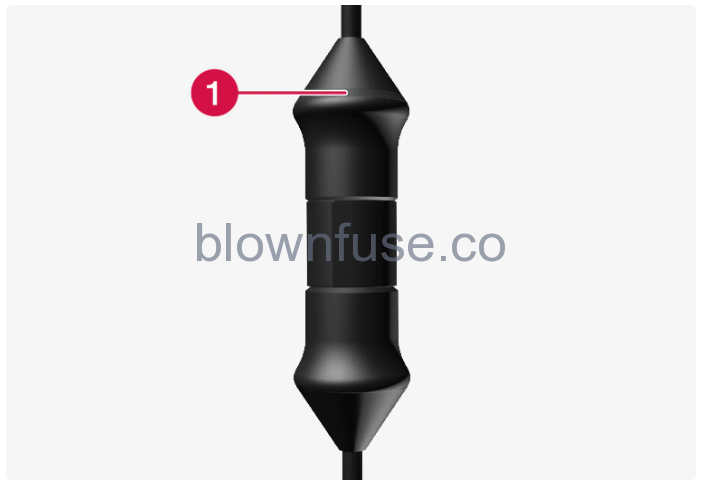
- LED lamp
If the control unit’s built-in ground fault breaker is tripped then the LED lamp illuminates with a red constant glow – check the wall socket. Ask a licensed electrician to check the socket or try to use another electrical socket.
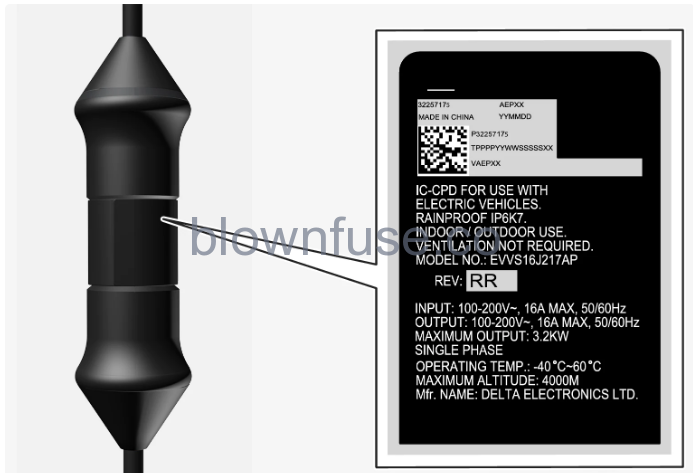
Important
- Check the capacity of the socket.
- Other electronic equipment connected to the same fuse circuit must be disconnected if the total load is exceeded.
- Do not connect the charging cable if the socket is damaged, worn or defective.
Charging status in the charging cable’s control unit

Control unit LED(LED (Light Emitting Diode)) lamp.
- LED lamp
Important
Ensure that the charging cable is handled according to recommendations and instructions by reading the enclosed instructions.
| LED | Status | Specification | Recommended action |
|---|---|---|---|
| Extinguished | Charging is not possible. | No power supply to charging cable. |
|
| White light | Charging possible. | The charging cable is ready to be plugged into the car. |
If the LED lamp is white but charging is not possible:
|
| Flashes white | Charging in progress. | The car’s electronics have started charging
Charging in progress. |
Wait until the car is fully charged. |
| Illuminates in red | Charging is not possible. | Temporary fault. |
|
| Flashes red | Charging is not possible. | Critical fault. |
|
Charging cable temperature monitoring
Monitoring in the control unit
Charging is switched off if the temperature of the control unit is too high. This is to protect the electronics. This may take place at a high outside temperature, for example, or when strong sunlight shines directly on the control unit.
Monitoring at the plug
The charging current is reduced if the temperature at the plug is too high. If the temperature exceeds a critical level, charging is stopped completely.
ImportantIf the temperature monitoring has automatically lowered the charging current repeatedly and charging has been interrupted then the cause of the overheating must be investigated and rectified.
ImportantAvoid exposing the control unit and its plug to direct sunlight. In such cases, the overheating protection in the plug is at risk of reducing or interrupting the charging of the car.
ImportantIf charging is unintentionally stopped, both the charging cable and the car’s charging system should be checked by a trained and qualified Volvo service technician. The wall socket should also be checked by a licensed electrician.
harging an electric car via a wall socket
NoteThe information in this section refers to charging via a wall socket and a mode 2 charging cable.
Charging cable (mode 2)
When charging via a wall socket, use a charging cable with a control unit than can limit the amperage (mode 2).
NoteVolvo recommends a charging cable in accordance with IEC 62196 and IEC 61851 which supports temperature monitoring.
WarningOnly use the charging cable provided with your vehicle or a replacement cable purchased from a Volvo retailer.
WarningThe charging cable and its associated parts must not be swamped or immersed in water.
Warning
- The charging cable has a built-in circuit breaker. Charging must only take place with grounded and approved sockets.
- Children should be supervised when in the vicinity of the charging cable when it is plugged in.
- High voltage in the charging cable. Contact with high voltage can cause death or serious personal injury.
- Do not use the charging cable if it is damaged in any way. A damaged or inoperative charging cable must only be repaired by a workshop – an authorised Volvo workshop is recommended.
- Always position the charging cable so that it will not be driven over, stepped on, tripped over or damaged in some other way, or cause personal injury.
- Disconnect the charger from the wall outlet before cleaning it.
- Never connect the charging cable to an extension cord or a multiple plug socket.
- Do not use one or more adapters between the charging cable and the electrical socket.
- Do not connect one or more adapters of any type between charging cable and car.
- Do not use an external timer between the charging cable and the electrical socket.
Also, refer to the manufacturer’s instructions for using the charging cable and its components.
ImportantAvoid exposing the control unit and its plug to direct sunlight. In such cases, the overheating protection in the plug is at risk of reducing or interrupting the charging of the high-voltage battery.
Starting charging
Plug the charging cable into a 230 V socket.(The voltage in the socket may vary depending on market) Open the charging hatch. Note that the car must be switched off prior to charging. Remove the charging handle’s protective cover and then press the handle the whole way into the charging input socket for the car. The charging cable’s charging handle is fastened/locked in, and charging starts within 5 seconds.
NoteRead more about how charging is started in the section on Charging electric cars.
ImportantIf the fuse of the wall socket has too low a current capacity, the fuse could blow while the car is charging. Set the lowest amperage for charging in the car’s centre display before reconnecting charging. If the problems persist, contact a qualified electrician for investigation of further measures.
Warning
- The electric car must only be charged at the maximum permitted charging current or lower in accordance with applicable local and national recommendations for charging from wall sockets/plugs.
- The electric car must only be charged from approved grounded wall sockets.
- Avoid visibly worn, defective, or damaged main sockets since they may lead to fire damage and/or personal injury if used.
ImportantNever connect the charging cable when there is a risk of a thunderstorm or lightning strike.
Finish charging
End charging by pressing the button next to the car’s charging input socket, or via the button in the center display, and unplug the charging cable from the car’s charging input socket and then from the 230 V socket.(The voltage in the socket may vary depending on the market).
NoteRead more about how charging is ended in the section on Ending charging of electric cars.
ImportantCharging must be ended before unplugging the charging cable from the car’s charging input socket. If charging is not ended before the charging cable is disconnected, this may lead to damage to the charging cable or to the system.
Important
- Never unplug the charging cable from the wall socket while charging is in progress – there is then a risk of damaging the wall socket.
- Note that the charging cable must be unplugged from the car’s charging input socket before being unplugged from the wall socket, partly to avoid damage to the system, and partly to avoid stopping the charging unintentionally.
Fuse
Charging an electric car via a wall socket corresponds to a high load on the fuse.
ImportantEnsure that the wall socket fuse can handle the specified amperage for the charging cable. Normally several 230 V consumers are included in a fuse circuit, so additional consumers (e.g. lighting, vacuum cleaner, electric drill, etc.) can be on the same fuse.
ImportantCheck that the 230 V socket has adequate power capacity for charging electric vehicles – in the event of uncertainty, the socket must be checked by a qualified professional. If the power capacity of the socket is unknown – set the lowest amperage in the center display.
Example 1
If the car is connected to a wall socket (10 A) and the charging current is set at 16 A, then the car will attempt to draw 16 A from the mains power circuit – after a while the overloaded 10 A fuse for the socket will be tripped and battery charging stopped. In which case, reset the fuse for the socket and select a lower charging current in the centre display.
Example 2
If the car is connected to a wall socket (10 A) and the charging current is set at 10 A, then the car will draw 10 A from the mains power circuit. If additional consumers are connected to the same socket (or another socket in the same fuse circuit) then there is a risk that the 10 A fuse for the socket/fuse socket will be overloaded and triggered, at which point battery charging is stopped. In such cases, reset the fuse for the socket/fuse circuit and select a lower charging current in the center display – or disconnect other consumers from the socket/fuse circuit.
Example 3
If the car is connected to a wall socket (10 A) and the charging current is set at 6 A, then the car will only draw 6 A from the mains power circuit. Battery charging will of course take longer, but then additional consumers can be connected at the same time to the same socket/fuse circuit as long as the total load does not exceed the capacity of the socket/fuse circuit.
Charging an electric car
Location of charging input socket
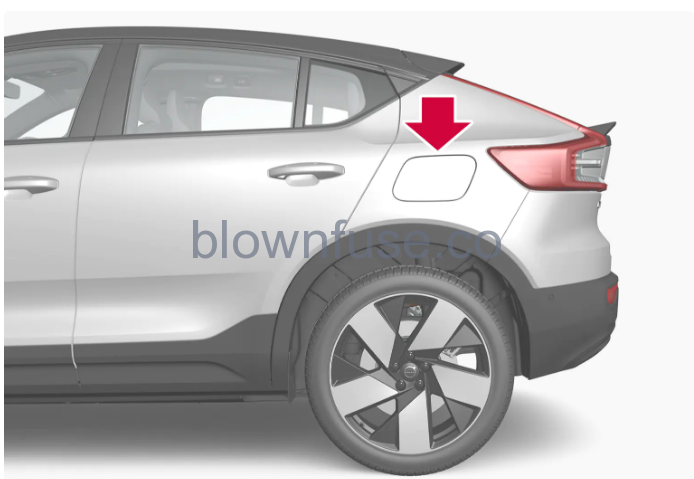
Charging via charging station (mode 3)
- Disconnect the charging cable from the charging station storage socket or take out the charging cable. Note that the car must be switched off prior to charging.
- Plug the charging cable into the charging station. If the charging station has a permanent charging cable, skip stepping .
Important. - Avoid plugging in the charging cable when there is a risk of a thunderstorm or lightning strikes.
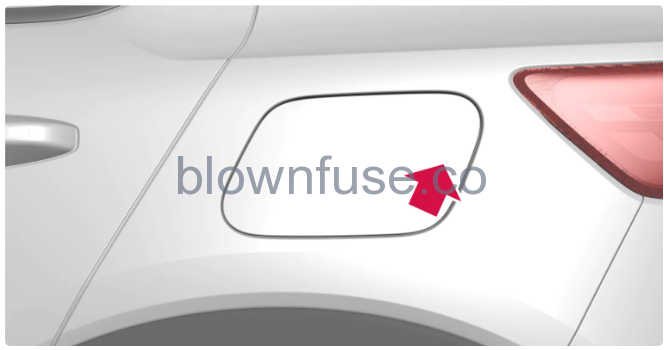
Press in the rear section of the cover to open the charging hatch.
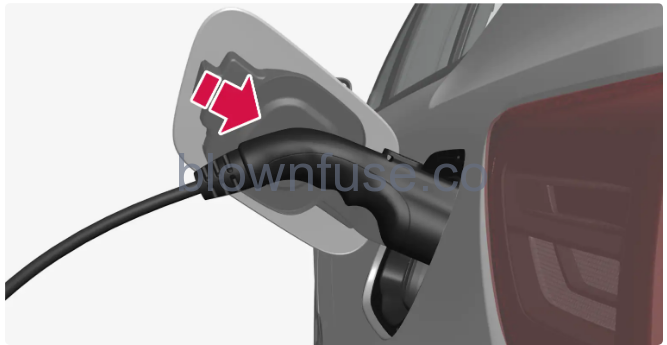
Remove the charging handle’s protective cover and press the charging handle the whole way into the charging input socket.
Important
To avoid damage to the paint, e.g. in the event of high winds, position the charging handle’s protective cover so that it does not touch the car. The charging cable’s charging handle is fastened/locked in, and charging starts within 5 seconds.
>When charging has started, the LED lamp in the charging input socket flashes green. The driver display and the centre display show the remaining estimated charging time or whether charging is not working as intended. Ensure that the amperage shown the centre display is set for the specified capacity of the charging station. Condensation from the air conditioning may drip under the car during charging. This takes place due to cooling the high voltage battery.
Warning
- Children should be supervised when in the vicinity of the charging cable when it is plugged in.
- High voltage in the charging cable. Contact with high voltage can cause death or serious personal injury.
- Do not use the charging cable if it is damaged in any way. A damaged or inoperative charging cable must only be repaired by a workshop – an authorised Volvo workshop is recommended.
- Always position the charging cable so that it will not be driven over, stepped on, tripped over or damaged in some other way, or cause personal injury.
- Do not use one or more adapters between the charging cable and the electrical socket.
- Do not connect one or more adapters of any type between charging cable and car.
Also, refer to the manufacturer’s instructions for using the charging cable and its components.
Important
Do not wash the car when the charging cable is connected or when the charging hatch is open.
Fast charging (direct current)
- Detach the charging cable from the charging station’s storage socket. Note that the car must be switched off prior to charging.
- Open the charging hatch and remove the protective cover for the charging input socket.
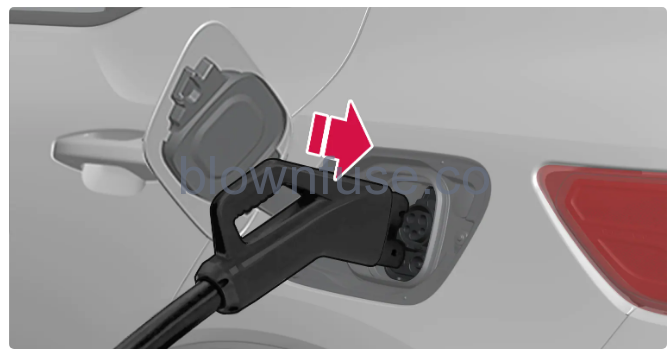
Grasp the charging cable with both hands and press the charging cable all the way into the car’s charging input socket. Hold the charging handle upwards for several seconds. The charging cable is automatically locked into the charging input socket after a couple of seconds. Ensure that the charging cable is properly locked so that charging can start. Follow the instructions in the charging station’s interface to authorize the charging. Charging begins when the charging station has executed an isolation test. This can take around one minute.
>When charging has started, the LED lamp in the charging input socket flashes with a green glow. The driver display and the centre display show the remaining estimated charging time or whether charging is not working as intended.
NoteCharging stations with support for CCS are normally clearly marked CCS or Combo.
Ending charging of an electric car
End charging at any time by pressing the button next to the charging input socket or via the button in the centre display.
Ending charging (alternating current)(Refers to charging with a mode-3 charging cable, or a charging station with a permanent charging cable)
- Press the button next to the charging input socket, or via the button in the centre display – the charging cable’s locked handle releases/is unlocked.
ImportantCharging must be ended before unplugging the charging cable from the car’s charging input socket. If charging is not ended before the charging cable is disconnected, this may lead to damage to the charging cable or to the system.
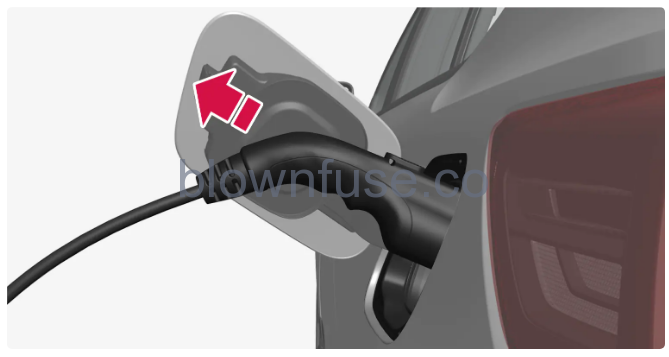
- Unplug the charging cable from the car’s charging input socket and close the hatch. Unplug the charging cable from the charging station, or plug the permanent charging cable into the charging station’s storage socket.
The charging cable is locked automatically
If the charging cable is not unplugged from the charging input socket, it is automatically locked in again shortly after unlocking in order to maximise the charging. The charging cable can be unplugged again using the button next to the charging input socket or via the button in the centre display.
Ending fast charging (direct current)
Important
Never try to unplug the charging cable from the car while charging is in progress. Always interrupt charging first and then unplug the charging cable when the lock in the car’s charging input socket has been automatically unlocked.
- End fast charging by pressing the button next to the car’s charging input socket, via the button in the centre display, or via the charging station’s user interface.
>Charging is ended and the lock in the charging input socket is unlocked automatically. This may take a couple of seconds. - Unplug the charging cable from the car’s charging input socket and close the hatch.
- Connect the charging cable to the charging station’s storage socket or hang it back in the designated location.
Unlocking the car during fast charging
Fast charging will not normally be interrupted if the car is unlocked. If fast charging is interrupted, it is not resumed automatically as the charging station requires charging to be reauthorised via the user interface. The charging cable will not lock automatically into place if fast charging is interrupted. To restart interrupted fast charging, unplug the charging cable from the car’s charging input socket, plug it in again, and follow the instructions in the charging station’s user interface.
In the event of problems releasing the charging handle
If the charging cable is left in the charging input socket for a while after charging has finished, the charging cable is automatically locked in again. Therefore, first try to end the charging again. If the charging handle still does not release automatically, proceed as follows:
- Make sure that the key is within range and that the car is unlocked.
- Switch off the power supply to the charging station in a safe manner. During charging via a charging station, contact the customer service for the charging station for assistance to end charging.
- Carefully wiggle the charging handle.
- Lock and unlock the car.
- Lock the car and wait until the LED lamp at the car’s charging input socket extinguishes. This can take up to 7 minutes. Then unlock the car. If the problem persists, contact your Volvo dealer.
Important
Never try to unplug the charging cable from the car while charging is in progress. Always end charging first by unlocking the car using the key or via the button in the centre display. Then disconnect the charging cable when the lock in the car’s charging input socket has been automatically unlocked.
Charging time
Charging time (alternating current)(Applies to charging using a 200-240 V socket)
| Current (A)(Maximum charging current may vary depending on market) | Charging power (kW)(The maximum charging power that the car can achieve is 11 kW) | Charging time (hours)(From 0–100%) | |
|---|---|---|---|
| Single motor(Standard range) | Twin motor(V)(Extended range.) | ||
| 6 | 1,3 | 64 | 72 |
| 10 | 2.2 | 36 | 40 |
| 16 | 3,6 | 22 | 24 |
| 32 | 7.2 | 11 | 12 |
| Current (A) | Charging power (kW)(The maximum charging power that the car can achieve is 11 kW) | Charging time (hours) | |
|---|---|---|---|
| Single motor(Standard range) | Twin motor(Extended range) | ||
| 6 | 4 | 20 | 22 |
| 10 | 6.8 | 12 | 14 |
| 16 | 11 | 8 | 8 |
Charging time when fast charging (direct current)
| Charging power (kW)(Maximum power that the charging station can supply) | Charging time(Applies at 10–80% state of charge (SoC) provided that the temperature of the battery is approximately 35°C (95°F)) (minutes) |
|---|---|
| 50 | 60 |
| 150 | 32 |
Note
In order to improve charging performance during fast charging, the battery is preconditioned when the destination in Google Maps is set at a fast-charging station.
Note
- It may take longer to charge the high voltage battery in cold or hot weather. Part of the charging current is then used to heat/cool the high voltage battery.
- If preconditioning is selected, the charging time may be affected.
- Fast charging at up to 150 kW power output is possible in good conditions for high voltage batteries and charging stations. The charging power is limited towards the end of fast charging.
